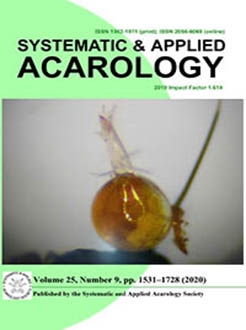Viticulture is an activity of economic importance in the state of Rio Grande do Sul, especially in Serra Gaúcha, which is the major grape-producing region. However, an increase in cultivated areas has been observed in other municipalities in the state. The aim of this study is to characterize mite diversity and community behavior on different varieties, recognizing which predatory species have potential to control phytophagous mites associated with Europan varieties in the Taquari Valley, Rio Grande do Sul state. The study was conducted in vineyards located in the municipalities of Marques de Souza: ‘BRS Vitória' and cv ‘Itália' “m”; Imigrante: cv ‘Itália' “i”; Dois Lajeados: cv ‘Itália' (c and f), ‘Tannat' and ‘Chardonnay'; and Putinga: ‘Champanhe' and ‘Moscato'. Samplings were carried out monthly in the period ranging from March 2017 to March 2018, during which twenty plants were randomly collected from each variety. Three leaves were clipped from each plant; one from the apical third, one from the median third, and one from the basal third, totaling 60 leaves per area. A total of 10,533 specimens were collected, belonging to 12 families, 38 genera, and 53 species, along with those belonging to the suborder Oribatida. The ‘Itália' “c” variety had the highest abundance (2,012), followed by ‘Moscato' (1,788) and ‘BRS Vitória' (1,593). Phytoseiidae had the highest diversity among the mite families observed, with 20 species followed by Tetranychidae (8). The most abundant species were Polyphagotarsonemus latus (Banks) (3,420) and Euseius concordis (Chant) (565), present throughout the study period. ‘Chardonnay' variety had the highest similarity (72.55%) among mite fauna compositions and the highest dissimilarity occurred between ‘BRS Vitória' and ‘Champanhe’ varieties (95.48%). Environments evaluated in Dois Lajeados and Putinga were the most homogeneous concerning mite fauna diversity and abundance.
How to translate text using browser tools
14 September 2020
Bioecological aspects of mites associated with Vitis vinifera varieties in the state of Rio Grande Do Sul, Brazil
Rita Tatiane Leão Da Silva,
Vinicius Leão Da Silva,
Darliane Evangelho Silva,
Joseane Moreira Do Nascimento,
Matheus Schüssler,
Franciele Fernandes Spies,
Amália Luisa Winter Berté,
Guilherme Liberato Da Silva,
Liana Johann,
Júlia Jantsch Ferla,
Elisete Maria De Freitas,
Noeli Juarez Ferla
ACCESS THE FULL ARTICLE
Euseius concordis
Euseius mesembrinus
grapevines
Polyphagotarsonemus latus
Tetranychus urticae
viticulture





